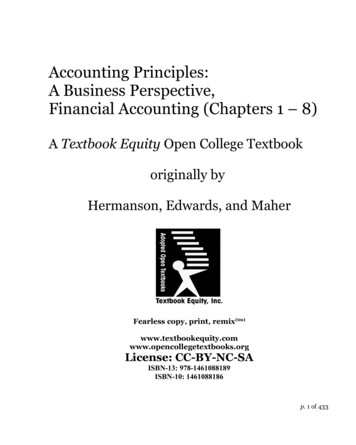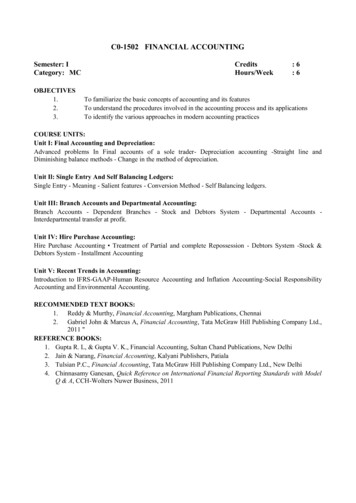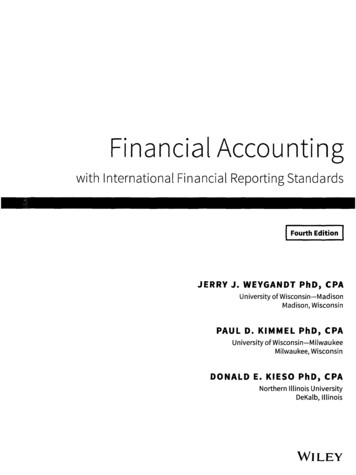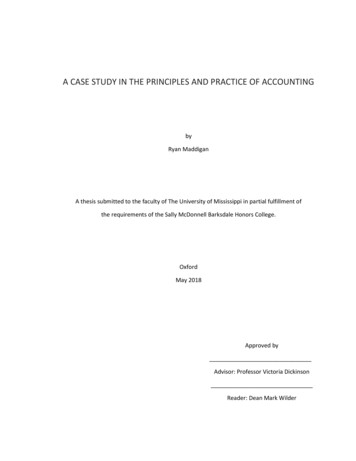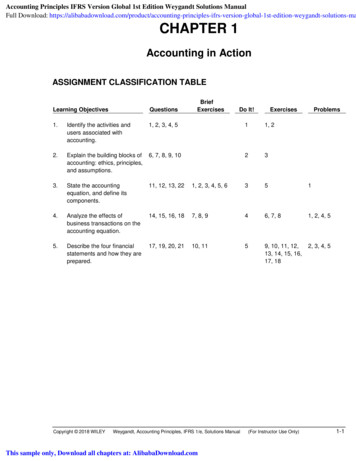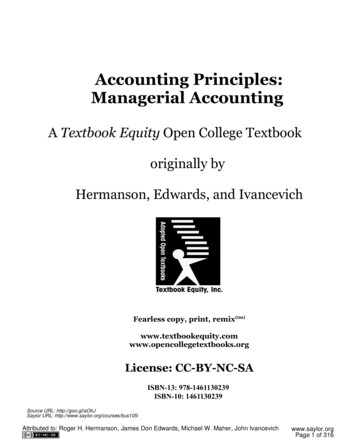
Transcription
Accounting Principles:Managerial AccountingA Textbook Equity Open College Textbookoriginally byHermanson, Edwards, and IvancevichFearless copy, print, books.orgLicense: CC-BY-NC-SAISBN-13: 978-1461130239ISBN-10: 1461130239Source URL: http://goo.gl/aOlrJSaylor URL: http://www.saylor.org/courses/bus105/Attributed to: Roger H. Hermanson, James Don Edwards, Michael W. Maher, John Ivancevichwww.saylor.orgPage 1 of 316
About This PublicationSimply put, you may copy, print, redistribute, and re-purpose this textbook or parts of thistextbook provided that you give attribution (credit) to Textbook Equity, and providedthat any derivative work has the same Creative Commons license (CC-BY-NC-SA). That’sit.Textbook Equity, in turn, provides attribution, with thanks, to the Global Text Project,who provided the source textbook.Consistent with it’s strategic mission to provide free and low-cost textbooks, this isTextbook Equity’s derivative work based on “Accounting Principles: A BusinessPerspective First Global Text Edition, Volume 2 Managerial Accounting”, utilizingthe permissions granted by it’s Creative Commons license. Global Text Project northe original authors endorse or are responsible in any way for this printing or it’scontents.Textbook Provenance (1998 - 2011)1998 EditionAccounting: A Business Perspective (Irwin/Mcgraw-Hill Series in Principles ofAccounting) [Hardcover] Roger H. Hermanson (Author), James Don Edwards(Author), Michael W. Maher (Author) Eighth EditionHardcover: 944 pagesPublisher: Richard D Irwin; Sub edition (April 1998)Language: EnglishISBN-10: 0075615851ISBN-13: 978-0075615859Product Dimensions: 11.1 x 8.7 x 1.8 inchesCurrent Hardbound Price 140.00 (Amazon.com)2010 Editions (http://globaltext.terry.uga.edu/books/)Global Text Project Conversion to Creative Commons License CC-BY“Accounting Principles: A Business Perspective First Global Text Edition, Volume 1Financial Accounting”, by Hermanson, Edwards, and Maher, Revision Editor:Donald J. McCubbrey, PhD.PDF Version, 817 pages, Free Download“Accounting Principles: A Business Perspective First Global Text Edition, Volume 2Managerial Accounting”, by Hermanson, Edwards, and Ivancevich. RevisionEditor: Donald J. McCubbrey, PhD.PDF Version Volume 2, 262 pages, Free DownloadSource URL: http://goo.gl/aOlrJSaylor URL: http://www.saylor.org/courses/bus105/2Attributed to: Roger H. Hermanson, James Don Edwards, Michael W. Maher, John Ivancevichwww.saylor.orgPage 2 of 316
2011 Editions (http://opencollegetextbooks.org)Textbook Equity publishes this soft cover version using a the CC-BY-NC-SA license.They divided Volume 1 into two sections to fit paperback publishing requirementsand made other formatting changes. No content changes were made to GlobalText’s version. Versions available at the Open College Textbook repository: PDF Version, Section 1 of Volume 1 (Chapters 1 – 8), 436 pages, Free Download Textbook Equity Paperback, Principles of Accounting, Volume 1 ,Financial Accounting(Chapters 1 – 8), 436 pages, List Price 24.95 PDF Version, Financial Accounting (Chapters 9 – 18), Free Download Textbook Equity Paperback, Principles of Accounting, Volume 1 , Financial Accounting(Chapters 9 – 18), List Price 14.95 PDF Version, Accounting Principles: Managerial Accounting, Free Download Textbook Equity Paperback, Accounting Principles: Managerial Accounting, 316 pages,(chapters 19 – 26 of the original volume). List Price 24.95For original author information and acknowledgments see opencollegetextbooks.orgUpdated April 27, 2011Source URL: http://goo.gl/aOlrJSaylor URL: http://www.saylor.org/courses/bus105/3Attributed to: Roger H. Hermanson, James Don Edwards, Michael W. Maher, John Ivancevichwww.saylor.orgPage 3 of 316
Contents (Cont' from Vol 1," Financial Accounting")19 Process: Cost systems.919.1 Learning objectives.919.2 Nature of a process cost system.919.3 Process costing illustration.1119.4 Process costing in service organizations.2219.5 Spoilage.2219.6 Understanding the learning objectives.2319.7 Appendix 19A: The FIFO process cost method.2519.8 FIFO process costing—An illustration.2619.9 Appendix 19B: Allocation of joint costs.3019.10 Demonstration problem.3219.11 Solution to demonstration problem.3219.12 Key terms.3319.13 Self-test.3419.14 Questions.3619.15 Exercises.3719.16 Problems.3819.17 Alternate problems.4019.18 Beyond the numbers—Critical thinking.4119.19 Using the Internet—A view of the real world.4319.20 Answers to self-test.4419.21 Comprehensive review problem.4420 Using accounting for quality and cost management.4720.1 Learning objectives.4720.2 Importance of good accounting information.4720.3 Quality and the new production environment.4820.4 Improving quality.4820.5 Quality and customer satisfaction measures.5220.6 Just-in-time method.5720.7 Activity-based costing and management.6220.8 Methods used for activity-based costing.6520.9 Impact of new production environment on cost drivers.7120.10 Activity-based costing in marketing.7120.11 Strategic use of activity-based management.7220.12 Behavioral and implementation issues.7220.13 Opportunities to improve activity-based costing in practice.7320.14 Understanding the learning objectives.7320.15 Demonstration problem.7420.16 Solution to demonstration problem.7520.17 Key terms.76Source URL: http://goo.gl/aOlrJSaylor URL: http://www.saylor.org/courses/bus105/4Attributed to: Roger H. Hermanson, James Don Edwards, Michael W. Maher, John Ivancevichwww.saylor.orgPage 4 of 316
20.18 Self-test.7620.19 Questions.7820.20 Exercises.7920.21 Problems.8220.22 Alternate problems.8520.23 Beyond the numbers—Critical thinking.8720.24 Using the Internet—A view of the real world.8920.25 Answers to self-test.8921 Cost-volume-profit analysis.9121.1 Learning objectives.9121.2 A manager's perspective.9121.3 Cost behavior patterns.9221.4 Methods for analyzing costs.9621.5 Cost-volume-profit (CVP) analysis.9821.6 Finding the break-even point.10021.7 Cost-volume-profit analysis illustrated.10421.8 Assumptions made in cost-volume-profit analysis.10721.9 Using computer spreadsheets for CVP analysis.10721.10 Effect of automation on cost-volume-profit analysis.10921.11 Understanding the learning objectives.11021.12 Demonstration problem .11121.13 Solution to demonstration problem .11121.14 Key terms*.11221.15 Self-test.11321.16 Questions.11421.17 Exercises.11521.18 Problems.11721.19 Alternate problems.12021.20 Beyond the numbers—Critical thinking.12221.21 Using the Internet—A view of the real world.12421.22 Answers to self-test.12422 Short-term decision making: Differential analysis.12622.1 Learning objectives.12622.2 Contribution margin income statements.12622.3 Differential analysis.12822.4 Applications of differential analysis.13122.5 Applying differential analysis to quality.13722.6 Understanding the learning objectives.13822.7 Demonstration problem.14022.8 Solution to demonstration problem.14022.9 Key terms*.14122.10 Self-test.141Source URL: http://goo.gl/aOlrJSaylor URL: http://www.saylor.org/courses/bus105/5Attributed to: Roger H. Hermanson, James Don Edwards, Michael W. Maher, John Ivancevichwww.saylor.orgPage 5 of 316
22.11 Questions.14222.12 Exercises.14322.13 Problems.14522.14 Alternate problems.14822.15 Beyond the numbers—Critical thinking.15022.16 Using the Internet—A view of the real world.15222.17 Answers to self-test.15323 Budgeting for planning and control.15423.1 A manager's perspective.15423.2 The budget—For planning and control.15523.3 The master budget illustrated.16123.4 Budgeting in merchandising companies.17723.5 Budgeting in service companies.17823.6 Additional concepts related to budgeting.17823.7 Understanding the learning objectives.17923.8 Demonstration problem.18023.9 Solution to demonstration problem.18123.10 Key terms*.18123.11 Self-test.18223.12 Questions.18323.13 Exercises.18423.14 Problems.18523.15 Alternate problems.18823.16 Beyond the numbers—Critical thinking.19123.17 Using the Internet—A view of the real world.19223.18 Comprehensive problems.19323.19 Answers to self-test.19624 Control through standard costs.19824.1 Learning objectives.19824.2 Uses of standard costs.19824.3 Nature of standard costs.19824.4 Advantages and disadvantages of using standard costs.20124.5 Computing variances.20324.6 Goods completed and sold.21624.7 Investigating variances from standard.21624.8 Disposing of variances from standard.21724.9 Nonfinancial performance measures.21924.10 Activity-based costing, standards, and variances.21924.11 Understanding the learning objectives.22024.12 Demonstration problem.22224.13 Solution to demonstration problem.22224.14 Key terms.223Source URL: http://goo.gl/aOlrJSaylor URL: http://www.saylor.org/courses/bus105/6Attributed to: Roger H. Hermanson, James Don Edwards, Michael W. Maher, John Ivancevichwww.saylor.orgPage 6 of 316
24.15 Self-test.22424.16 Questions.22624.17 Exercises.22724.18 Problems.22824.19 Alternate problems.22924.20 Beyond the numbers—Critical thinking.23024.21 Using the Internet—A view of the real world.23224.22 Answers to self-test.23225 Responsibility accounting: Segmental analysis.23425.1 Learning objectives.23425.2 Responsibility accounting.23425.3 Responsibility reports.23625.4 Responsibility reports—An illustration.23825.5 Responsibility centers.24025.6 Transfer prices.24325.7 Use of segmental analysis.24325.8 Concepts used in segmental analysis.24425.9 Investment center analysis.24825.10 Economic value added and residual income.25325.11 Segmental reporting in external financial statements.25525.12 Understanding the learning objectives.25525.13 Appendix: Allocation of service department costs.25625.14 Demonstration problem.25825.15 Solution to demonstration problem.25925.16 Key terms*.25925.17 Self-test.26025.18 Questions.26225.19 Exercises.26325.20 Problems.26525.21 Alternate problems.26925.22 Beyond the numbers—Critical thinking.27125.23 Using the Internet—A view of the real world.27325.24 Answers to self-test.27426 Capital budgeting:Long-range planning.27626.1 Learning objectives.27626.2 Capital budgeting defined.27726.3 Project selection: A general view.27826.4 Project selection: Payback period.28226.5 Project selection: Unadjusted rate of return.28426.6 Project selection: Net present value method.28626.7 Profitability index.28726.8 Project selection: The time-adjusted rate of return (or internal rate ofSource URL: http://goo.gl/aOlrJSaylor URL: http://www.saylor.org/courses/bus105/7Attributed to: Roger H. Hermanson, James Don Edwards, Michael W. Maher, John Ivancevichwww.saylor.orgPage 7 of 316
return).28926.9 Investments in working capital.29226.10 The postaudit.29326.11 Investing in high technology projects.29326.12 Capital budgeting in not-for-profit organizations.29426.13 Epilogue.29426.14 Understanding the learning objectives.29426.15 Demonstration problem.29526.16 Solution to demonstration problem.29626.17 Key terms*.29726.18 Self-test.29826.19 Questions.29926.20 Exercises.30026.21 Problems.30226.22 Alternate problems.30526.23 Beyond the numbers—Critical thinking.30726.24 Using the Internet—A view of the real world.30926.25 Answers to self-test.310Source URL: http://goo.gl/aOlrJSaylor URL: http://www.saylor.org/courses/bus105/8Attributed to: Roger H. Hermanson, James Don Edwards, Michael W. Maher, John Ivancevichwww.saylor.orgPage 8 of 316
19 Process: Cost systems19.1 Learning objectivesAfter studying this chapter, you should be able to: Describe the types of operations that require a process cost system. Distinguish between process and job costing systems. Discuss the concept of equivalent units in a process cost system. Compute equivalent units of production and unit costs under the average cost procedure. Prepare a production cost report for a process cost system and discuss its relationship to theWork in Process Inventory account. Distinguish between normal and abnormal spoilage. Compute equivalent units of production and unit costs under the first-in first-out (FIFO)system (Appendix 19-A). Discuss how joint costs are allocated to joint products (Appendix 19-B).This chapter continues the discussion of cost accumulation systems. In Chapter 18, we explainedand illustrated job costing. The job cost system (job costing) accumulates costs incurred toproduce a product according to individual jobs. For example, construction companies use job costingto keep track of the costs of each construction job.This chapter discusses another cost accumulation system, process costing. The chapter beginswith a discussion of the nature of a process cost system. We review the similarities and differencesbetween job costing and process costing. We also present an extended illustration of process costingthat includes a discussion of equivalent units of production and the production cost report. In thechapter appendixes, we discuss and illustrate FIFO process costing and the allocation of joint productcosts.19.2 Nature of a process cost systemMany businesses produce large quantities of a single product or similar products. Pepsi-Colamakes soft drinks, Exxon Mobil produces oil, and Kellogg Company produces breakfast cereals on acontinuous basis over long periods. For these kinds of products, companies do not have separate jobs.Instead, production is an ongoing process.A process cost system (process costing) accumulates costs incurred to produce a productaccording to the processes or departments a product goes through on its way to completion.Source URL: http://goo.gl/aOlrJSaylor URL: http://www.saylor.org/courses/bus105/9Attributed to: Roger H. Hermanson, James Don Edwards, Michael W. Maher, John Ivancevichwww.saylor.orgPage 9 of 316
Companies making paint, gasoline, steel, rubber, plastic, and similar products using process costing.In these types of operations, accountants must accumulate costs for each process or departmentinvolved in making the product. Accountants compute the cost per unit by first accumulating costsfor the entire period (usually a month) for each process or department. Second, they divide theaccumulated costs by the number of units produced (tons, pounds, gallons, or feet) in that process ordepartment.In "A broader perspective: Producing cans of Coca-Cola", we describe production in bottling andcanning plants that use a process cost system. Job costing and process costing have importantsimilarities: Both job and process cost systems have the same goal: to determine the cost of products. Both job and process cost systems have the same cost flows. Accountants record productionin separate accounts for materials inventory, labor, and overhead. Then, they transfer the coststo a Work in Process Inventory account. Both job and process cost systems use predetermined overhead rates (defined in Chapter 18)to apply overhead.Job costing and process costing systems also have their significant differences: Types of products produced. Companies that use job costing work on many different jobswith different production requirements during each period. Companies that use process costingproduce a single product, either on a continuous basis or for long periods. All the products thatthe company produces under process costing are the same. Cost accumulation procedures. Job costing accumulates costs by individual jobs. Processcosting accumulates costs by process or department. Work in Process Inventory accounts. Job cost systems have one Work in Process Inventoryaccount for each job. Process cost systems have a Work in Process Inventory account for eachdepartment or process.Exhibit 1 shows the cost flows in a process cost system that processes the products in a specifiedsequential order. That is, the production and processing of products begin in Department A. FromDepartment A, products go to Department B. Department B inputs direct materials and furtherprocesses the products. Then Department B transfers the products to Finished Goods Inventory. Forillustration purposes, we assume that all the process cost systems in this chapter are sequential.There are many production flow combinations; Exhibit 2 presents three possible production flowcombinations.Source URL: http://goo.gl/aOlrJSaylor URL: http://www.saylor.org/courses/bus105/10Attributed to: Roger H. Hermanson, James Don Edwards, Michael W. Maher, John Ivancevichwww.saylor.orgPage 10 of 316
19.3 Process costing illustrationAssume that Jax Company manufactures and sells a chemical product used to clean kitchencounters and sinks. The company processes the p
Apr 27, 2011 · PDF Version, 817 pages, Free Download “Accounting Principles: A Business Perspective First Global Text Edition, Volume 2 Managerial Accounting”, by Hermanson, Edwards, and Ivancevich. Revision Editor: Donald J. McCubbrey, PhD. PDF Version Volume 2, 262 pages,

